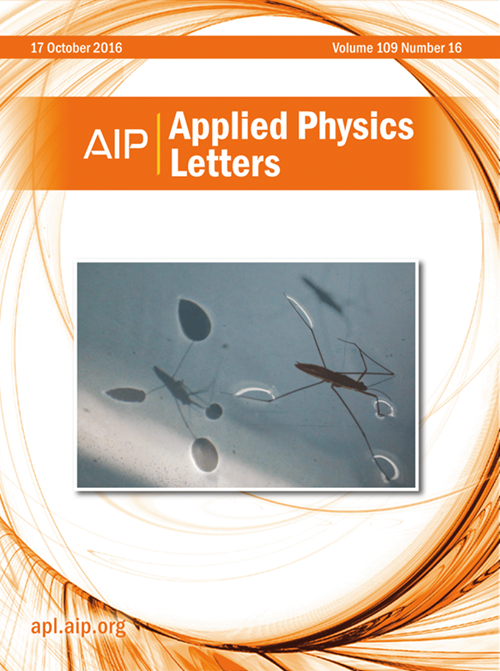Modulation of charge transport and rectification behavior in CsSnI3 thin films through A-site cation engineering
IF 3.5
2区 物理与天体物理
Q2 PHYSICS, APPLIED
引用次数: 0
Abstract
CsSnI3 perovskite is a thin-film semiconductor with high intrinsic conductivity for various device applications (thermoelectric, photovoltaics, etc.). Stoichiometric CsSnI3 has high-density defects and structural imperfections affecting device performance. In this work, we made an investigation on A-site cation engineering to evaluate the correlation between structural and transport parameters for effective operation in rectifying devices. Here, we analyzed CsSnI3 thin films modified with methylamine (MA), formamidine (FA), guanidine (GuA), and 5-ammonium valeric acid (AVA) cations, correlating structural parameters obtained by Rietveld refinement with their optoelectronic and diode characteristics. MA-, FA-, and GuA-substituted films exhibited low sheet resistance (∼450–2200 Ω/sq); however, strain-induced lattice distortions and accumulated defects in GuA-substituted films significantly hindered effective charge collection and increased recombination losses. AVA substitution formed low-conductivity 2D interlayers, increasing resistance (>105 Ω/sq) and altering transient response characteristics, yet provided minimal reverse switching losses (∼100 μW/cm2), beneficial for high-frequency applications. FA substitution emerged as optimal, balancing structural stability, conductivity, minimal defects, and relevant diode properties. The obtained results highlight that targeted lattice modifications strongly influence the practical performance of rectifying p–i–n diodes based on CsSnI3.利用a位阳离子工程调制CsSnI3薄膜中的电荷输运和整流行为
CsSnI3钙钛矿是一种薄膜半导体,具有高本征电导率,适用于各种器件(热电、光伏等)。化学计量学CsSnI3具有高密度缺陷和影响器件性能的结构缺陷。在这项工作中,我们对a点阳离子工程进行了调查,以评估结构和运输参数之间的相关性,以有效地运行整流装置。在这里,我们分析了甲胺(MA)、甲脒(FA)、胍(GuA)和5-戊酸铵(AVA)阳离子修饰的CsSnI3薄膜,并将Rietveld精化所得的结构参数与其光电和二极管特性相关联。MA-、FA-和gua -取代膜表现出低片电阻(~ 450-2200 Ω/sq);然而,应变引起的晶格畸变和累积的缺陷严重阻碍了gua取代膜的有效电荷收集,增加了复合损失。AVA取代形成了低电导率的2D中间层,增加了电阻(>105 Ω/sq)并改变了瞬态响应特性,同时提供了最小的反向开关损耗(~ 100 μW/cm2),有利于高频应用。FA替代是最优的,平衡了结构稳定性、电导率、最小缺陷和相关二极管特性。研究结果表明,定向晶格修饰对基于CsSnI3的p-i-n整流二极管的实际性能有很大影响。
本文章由计算机程序翻译,如有差异,请以英文原文为准。
求助全文
约1分钟内获得全文
求助全文
来源期刊

Applied Physics Letters
物理-物理:应用
CiteScore
6.40
自引率
10.00%
发文量
1821
审稿时长
1.6 months
期刊介绍:
Applied Physics Letters (APL) features concise, up-to-date reports on significant new findings in applied physics. Emphasizing rapid dissemination of key data and new physical insights, APL offers prompt publication of new experimental and theoretical papers reporting applications of physics phenomena to all branches of science, engineering, and modern technology.
In addition to regular articles, the journal also publishes invited Fast Track, Perspectives, and in-depth Editorials which report on cutting-edge areas in applied physics.
APL Perspectives are forward-looking invited letters which highlight recent developments or discoveries. Emphasis is placed on very recent developments, potentially disruptive technologies, open questions and possible solutions. They also include a mini-roadmap detailing where the community should direct efforts in order for the phenomena to be viable for application and the challenges associated with meeting that performance threshold. Perspectives are characterized by personal viewpoints and opinions of recognized experts in the field.
Fast Track articles are invited original research articles that report results that are particularly novel and important or provide a significant advancement in an emerging field. Because of the urgency and scientific importance of the work, the peer review process is accelerated. If, during the review process, it becomes apparent that the paper does not meet the Fast Track criterion, it is returned to a normal track.
 求助内容:
求助内容: 应助结果提醒方式:
应助结果提醒方式:


